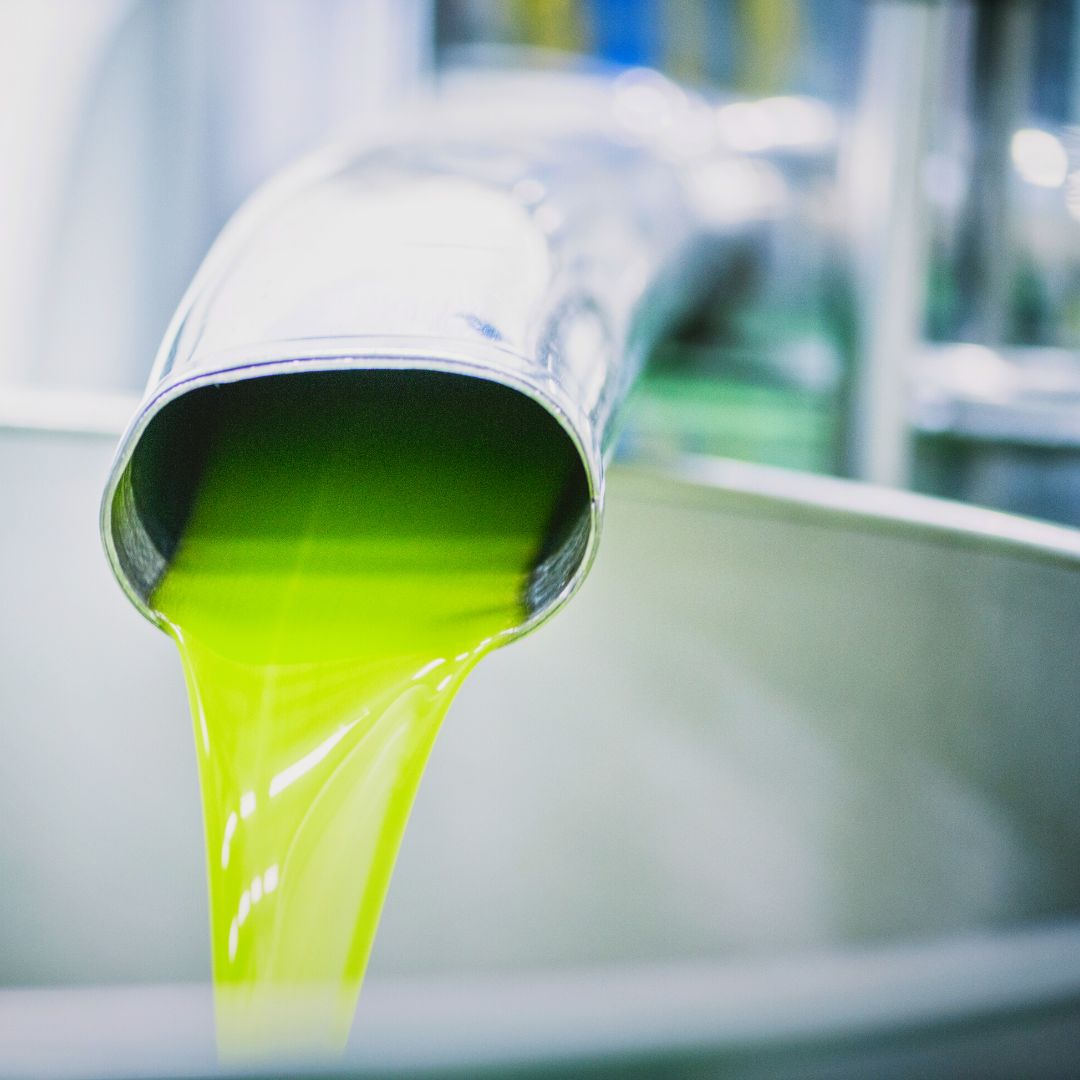Fresh Pressed Olive Oil [October 2022]
Fresh pressed olive oil provides unique health benefits and a great flavor. Learn how to identify and use it. Come taste our family’s new harvest EVOO.
Lazy? Quick Read.
Key takeaways on the best ways to enjoy fresh harvest olive oil.
1. Fresh olive oil provides numerous health and sensory benefits.
2. Around the Mediterranean, fresh olive oil is produced between September and February.
3. If you prefer polyphenol rich olive oil with extra health benefits, you should choose olive oil that has been produced between September and November, while the olive fruit is still green.
4. Fresh olive oil from Europe typically reaches foreign markets between December and May. However, there is no guarantee that all olive oil around this time will be fresh.
5. The best guarantee for acquiring fresh pressed olive oil is to know your producer and know the exact production period.
6. To keep extra virgin olive oil fresh make sure it is filtered and remember to store it in the best possible conditions.

Author: Athanasios Demeslis
Producer of Myrolion
This article has been meticulously prepared by Athanasios to help you identify the ways to best enjoy fresh olive oil, for you and your loved ones.
Athanasios has years of experience with olive farming, olive oil extraction, and sensory evaluation of olive oil.
Why Choose Fresh Pressed Olive Oil?
Consumers and even the olive oil industry itself treat extra virgin olive oil as an ambient food. This could not be further from the truth. Olive oil degrades over time and especially when exposed to “room temperature.” Its pleasant sensory features fade away, polyphenols decrease while battling intrinsic oxidation and sensory defects can quickly appear.
This is why most super market olive oil audits find 50%-70% of olive oil brands to be mislabeled. Most olive oil brands claim extra virginity on their label, but unfortunately they are not extra virgin by the time they become available to consumers.
Sourcing and buying fresh olive oil is the best way to experience the full benefits of early harvest extra virgin olive oil. However, you need to have a trained eye to identify fresh pressed olive oil.
Fresh Pressed Olive Oil Benefits
All types of olive oil provide health benefits that are related to the healthy fatty acids that comprise it.
However, olive oil that is carefully extracted from unripe olives contains unique nutrients and volatile compounds. These additional compounds provide more health benefits and a greater culinary experience.
The fresher the olive oil, the more the benefits:
Fresh Fruity Taste
Fresh early harvest olive oil is filled with fruity aromas that, depending on the olive cultivar, remind of tomato, almond, grass, flowers, etc. By including fresh olive oil in your dishes these sensory details can uplift the overall taste of your meals.
There’s nothing better than enjoying the taste of healthful meals.
Antioxidative Health Benefits
The fresher the olive oil the higher the phenolic concentration. Polyphenols are natural antioxidants, some unique to olive oil, that have been found to have a diverse range of benefits against many health conditions.
Learn more about health benefits of olive oil polyphenols.
Frequently Asked Questions About Fresh Olive Oil
While it is easy to discern fresh bananas from overripe ones, it is not as easy with olive oil. For this reason, many consumers spend more money than average on olive oil brands that look the part but don’t deliver.
Below we answer questions that can save you money and can help you get the olive oil that is best for your needs.
How Long Does Fresh Pressed Olive Oil Last?
Olive oil can remain fresh from a couple of months to two years. It depends on producers’, retailers’, and consumers’ practices. This is why it is important to do your research before choosing an olive oil brand. Here’s what to look out for:
Producers:
- If olive oil remains unfiltered from various solid residues it can quickly ferment and produce sensory defects. This is why it is important to choose filtered olive oil. Filtered olive oil has an immensely longer shelf-life than unfiltered olive oil. The filtration process removes less than 5% of polyphenols and volatile compounds, which makes it a good choice for long-term nutritional benefits.
- Producers should also keep an eye on olive oil humidity. Although this is a highly technical matter, consumers should now that it is possible for tiny water particles to find themselves in olive oil. This can happen due to bad segmentation between water and oil in the olive press. Most truly high quality olive oils, including Myrolion, typically have below 2‰ of water in olive oil, which makes degradation a very slow process.
These two factors can guarantee that your olive oil has the best possible structure to remain fresh for a very long time, typically over 12-18 months.
Retailers:
Waiting on a retail shelf for months—even years—to be bought can really affect olive oil quality. Besides room temperature, which can be hostile for olive oil quality, constant exposure to light guarantees that the oil will be far from fresh by the time it reaches your table.
Unfortunately, the distribution model is not compatible with olive oil quality.
This is the reason why many consumers choose to get their olive oil online, directly from their personal producer, who should make sure to store the product in ideal conditions.
Consumers – How to Keep Olive Oil Fresh:
The way you treat olive oil once it reaches your kitchen will affect for how long you can enjoy all of its benefits.
Keep it between 12°C (53.6°F) and 18°C (64.4°F). If you have a cellar make sure to store your olive oil there, just like good wines. If you don’t have a cellar and you live in an area where temperature frequently goes above 20°C (68°F), then refrigerating your olive oil will be a good idea.
If you get your olive oil from a careful producer and treat it with care once it reaches your home, you can expect it to remain fresh for at least 12 months. Right on time to get next season’s new harvest olive oil!
Best Time to Buy Fresh Olive Oil
If you want to get fresh olive oil from the Mediterranean as soon as possible November and December are the best months. However, there is no guarantee that your super market’s olive oil shelfs will have updated by then, or that they will update at all.
Since western markets have a very low per capita olive oil consumption, olive oil can be described as a slow moving consumer good. For this reason, retailers push for a long shelf-life, even if most olive oil brands cannot deliver. This is why you typically see two-year best before dates on olive oil bottles that are dusty from waiting on the shelf for all this time.
In addition, it is not as easy to know when olive oil was produced because brands are not obliged by law to indicate the production date. Instead, it is enough to indicate a lot number for traceability purposes. Make sure to choose an olive oil brand that specifically indicates a production date.
When Does New Harvest Olive Oil From Europe Reach UK Market?
Expect fresh olive oil to reach UK retailers from late November, all the way to early Spring.
When Does New Harvest Olive Oil From Europe Reach US Market?
It can take a bit more time for new harvest olive oil to reach US retailers. Expect fresh olive oil to reach US markets from December to late Spring. However, since typically sales increase around Christmas, it is a good chance for most retailers to move last season’s stock. So, it is typical for fresh olive oil to become available around January.
How Does Our Family Produce Fresh Olive Oil?
We started producing this year’s fresh olive oil in early October and finished harvesting and pressing on October 30th.
Myrolion’s 2022-2023 batch is extra virgin, organic and has an increased polyphenol concentration for the sixth year in a row. Check this season’s analyses and certificates here.
- Every year we start harvesting when approximately 80% of the olive fruit approaches maturity index 2 (i.e., olive fruit is mostly green and only a small part has started turning red). This way we guarantee optimal quality and yield ratio.








